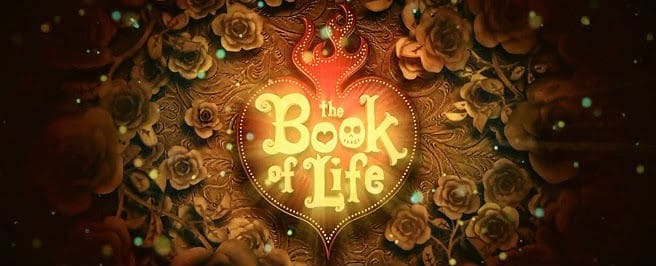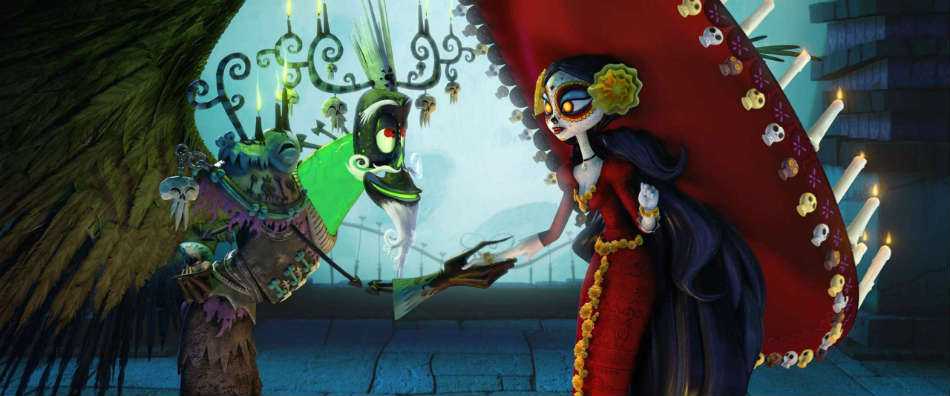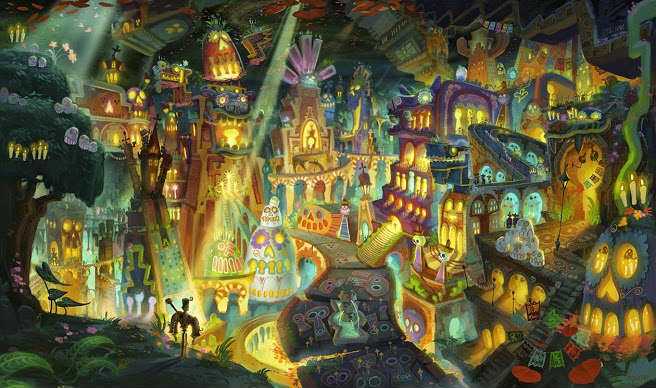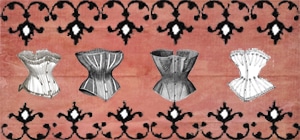
The first time I watched The Book of Life I did not really know what to expect. Though I was hoping for it to be good, I was a little worried that I would be disappointed. This is the production studio Reel FX Creative Studios’ second film. Their first was Free Birds, a Thanksgiving movie that I was personally not thankful for. But I still wanted to give the studio and this film a chance because The Book of Life caught my interest with its animation style and the Day of the Dead theme.
The Story

The story begins when La Muerte the goddess of the Land of the Remembered and Xibalba the god of the Land of the Forgotten observe three children, Maria, Joaquín, and Manolo, playing in a grave yard on the Day of the Dead. The two gods make a bet of who Maria will grow up to marry, either Joaquín or Manolo. Now two guys fighting over the pretty girl is nothing new and, admittedly, the story is littered with other familiar elements such as the town hero, the underdog, and the father who wants his son to follow the family business. With that said, the film executes these elements successfully with charming and likable characters, quirky humor, as well as the incorporation of different spins on these traditional story elements.
According to my Mexican friends who have also seen this film, this animated feature portrays the Day of the Dead accurately, respectfully, and with dignity. The Book of Life doesn’t shy away from conflict, and it doesn’t sugar-coat the elements of death and loss that are so central to the story. The film is proudly Mexican and Latin American, which really comes through in the film. One doesn’t get the feeling that someone from the U.S. looked at Mexican culture and picked what went into the film based on the feelings of a strictly American audience. The Book of Life brings cultural diversity to a medium that desperately needs it, and I personally appreciate it for that. The film explains what the Mexican holiday is all about and the folktales that go with it. It explores the lands of the dead and what life is like after death in an entertaining and educational way. This makes sense, as the story is told by a museum tour guide to a group of kids. Another element that I enjoy about the film is its morals. It makes us consider animal cruelty, compassion, the importance of forgiveness, and writing your own story. The Book of Life is an honest story, told from the heart; one that reaffirms values like integrity, self-sacrifice, and letting others be who they are instead of whom we think they ought to be. While the plot is not completely original, the ideologies and cultural diversity it brings are truly admirable.
The Characters

Photo: Reel FX Creative Studios
Similar to the story, the charm of the characters is not how they are written but how they are executed. Going by the concepts, they sound like typical characters one might see in other animated films. However, each of the three main characters have an added depth to them. For example, Manolo symbolizes the heart. He wants to be a musician but his father wants him to be a bull fighter, thus following the family tradition. What makes him a likable character is his love for Maria. He is so passionate in his desire to be with her that it makes the audience want to see him succeed in that goal. This passion is not just limited to Maria, but to his family and the others things he loves such as animals and his music. Maria is the love interest, but at the same time she embodies something greater than that simple stereotype. Maria is an iconoclast. She is headstrong, fighting for justice even if her ideas are, at times, a bit unwise. She has her own plans, desires and emotions which go beyond that of a stereotypical female character. Joaquín is the proud town hero who is primeval, misogynist and a bit full of himself. The writers could have made Joaquín into a more a villainous parody of a hero, yet they avoid that trap in a few ways. First, Joaquín is an orphan living under his father’s shadow while at the same time following in his footsteps. Moreover, as much as Joaquin loves himself, there is still enough room in his heart for San Angel and everyone in it. Manolo, Joaquin, and Maria have been friends since childhood, adding some depth to their characters and an deep understanding of each other. Though Joaquín and Manolo can verbally cut each other deeply, there is this sense that neither one of them can truly hate each other. They are still supportive of each other and their friendship remains strong throughout the course of the film.
This film has a large cast of characters and every one of them has their own unique personality and likability, along with their own creative design.
In terms of the romance, I am personally very picky when it comes to love triangles. I will give the writers credit, however, with this love triangle. I was happy to see that the rivals are both good people and both have a real chance. Though Joaquín is a bit self-centered, his love of Maria still comes from a true place, and he goes through some really good character development of his own. Manolo and Maria are more compatible. They are alike in their ideals of compassion and social justice. Moreover, Manolo is more romantic in a way Joaquin is not, which is also an interesting contrast. What makes this love triangle work, in my opinion, is that the characters have plausible reasons to care about each other. Every character in said triangle respects the other, and none of the characters are purposely made to be unlikable. If a love triangle accomplishes these three things, then to me it is a well written love triangle instead of a source of hair tugging frustration.
Then there are all the other characters. This film has a large cast of characters and every one of them has their own unique personality and likability, along with their own creative design. This ranges from Manolo’s music friends, to Manolo’s family in the Land of the Remembered, to the village people, and to the bandits. Speaking of the bandits, I will say that because we do not know very much about the head bandit and his crew, they all end up becoming quite simple and generic villains. This results in the bandits being relegated to being the simple plot device of a foil for the other characters.
Then there is Xibalba and La Muerte, oh wow, Xibalba and La Muerte. These two are remarkable apart and even more remarkable together. They are by far the most interesting and entertaining characters in the entire film. Their chemistry is great and their tension is almost tangible. Moreover, I think they demonstrate an interesting commentary in how they each express different parts of human nature and our relationship with life and death. (They also may or may not have made my inner fangirl squeal).
The Animation

I’m pretty sure this goes without saying that the Book of Life is one of the best looking animated films of 2014. The amount of detail the animators put into everything looks spectacular. One of the film’s more unique traits is the character designs. They all look like wooden dolls with wooden textures and separated leg and arm joints. La Muerte and Xibalba are animated with much more fluidity and speed to their motions. They are constantly whizzing and dancing in circles around each other. This detail is brilliant in illustrating their celestial nature, as well as the subtle nature of their relationship. I also really enjoy how the film uses different forms of animation, such as 2D, in order to show flashbacks of a character’s background. This gives the film a nice variety of animation while maintaining the film’s Mexican art style. As the movie progresses, the backgrounds and settings become more fascinating to look at. The beginning at the museum gives the audience a hint of what is to come, the village provides great Mexican atmosphere, then the Land of the Remembered shows everything in more detail, vibrant colors and, ironically, liveliness.
The Book of Life is a beautiful and fascinating look into the Day of the Dead holiday and Mexican culture that tells a love story with amazing animation and memorable characters. I recommend it to animation fans, film fans, and people who want to see more diversity in the film industry in general. It is a film that celebrates the good things life has to offer, and I am so glad that it exists in the world.
Overall Rating:
Romance Rating:
 “In vain have I struggled. It will not do. My
“In vain have I struggled. It will not do. My
feelings will not be repressed. You must allow me
to tell you how ardently I admire and love you.”
ARE YOU A ROMANCE FAN? FOLLOW THE SILVER PETTICOAT REVIEW:
 Our romance-themed entertainment site is on a mission to help you find the best period dramas, romance movies, TV shows, and books. Other topics include Jane Austen, Classic Hollywood, TV Couples, Fairy Tales, Romantic Living, Romanticism, and more. We’re damsels not in distress fighting for the all-new optimistic Romantic Revolution. Join us and subscribe. For more information, see our About, Old-Fashioned Romance 101, Modern Romanticism 101, and Romantic Living 101.
Our romance-themed entertainment site is on a mission to help you find the best period dramas, romance movies, TV shows, and books. Other topics include Jane Austen, Classic Hollywood, TV Couples, Fairy Tales, Romantic Living, Romanticism, and more. We’re damsels not in distress fighting for the all-new optimistic Romantic Revolution. Join us and subscribe. For more information, see our About, Old-Fashioned Romance 101, Modern Romanticism 101, and Romantic Living 101.

